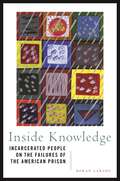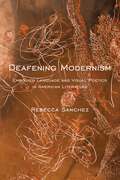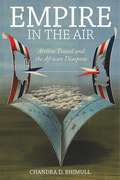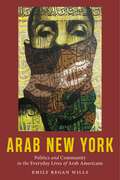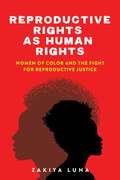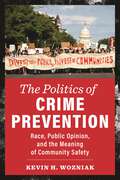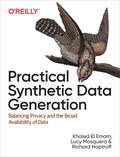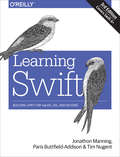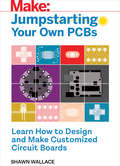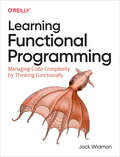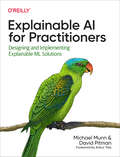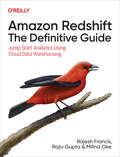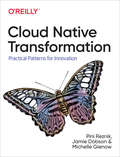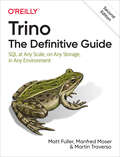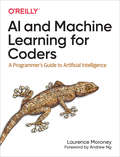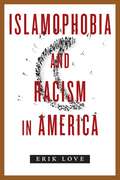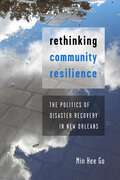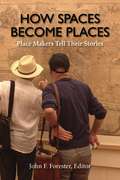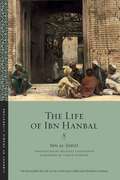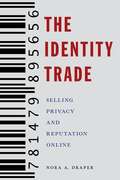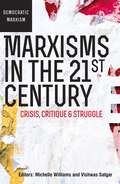- Table View
- List View
Inside Knowledge: Incarcerated People on the Failures of the American Prison
by Doran LarsonA powerful critique of mass incarceration by the people who have experienced itInside Knowledge is the first book to examine the American prison system through the eyes of those who are trapped within it. Drawing from the writings collected in the American Prison Writing Archive, Doran Larson deftly illustrates how mass incarceration does less to contain any harm perpetrated by convicted people than to spread and perpetuate harm among their families and communities.Inside Knowledge makes a powerful argument that America’s prisons not only degrade and debilitate their wards but also defeat the prison’s cardinal missions of rehabilitation, containment, deterrence, and even meaningful retribution. If prisons are places where convicted people are sent to learn a lesson, then imprisoned people are the ones who know just what American prisons actually teach. At once profound and devastating, Inside Knowledge is an invaluable resource for those interested in addressing mass incarceration in America.
Deafening Modernism: Embodied Language and Visual Poetics in American Literature (Cultural Front)
by Rebecca SanchezDeafening Modernism tells the story of modernism from the perspective of Deaf critical insight. Working to develop a critical Deaf theory independent of identity-based discourse, Rebecca Sanchez excavates the intersections between Deaf and modernist studies. She traces the ways that Deaf culture, history, linguistics, and literature provide a vital and largely untapped resource for understanding the history of American language politics and the impact that history has had on modernist aesthetic production.Discussing Deaf and disability studies in these unexpected contexts highlights the contributions the field can make to broader discussions of the intersections between images, bodies, and text. Drawing on a range of methodological approaches, including literary analysis and history, linguistics, ethics, and queer, cultural, and film studies, Sanchez sheds new light on texts by T.S. Eliot, Ezra Pound, Gertrude Stein, William Carlos Williams, Charlie Chaplin, and many others. By approaching modernism through the perspective of Deaf and disability studies, Deafening Modernism reconceptualizes deafness as a critical modality enabling us to freshly engage topics we thought we knew.
Empire in the Air: Airline Travel and the African Diaspora (Social Transformations in American Anthropology #1)
by Chandra D. BhimullHonorable Mention, 2019 Victor Turner Prize in Ethnographic Writing, given by the Society for Humanistic AnthropologyHonorable Mention, 2019 Sharon Stephens Prize, given by the American Ethnological SocietyExamines the role that race played in the inception of the airline industryEmpire in the Air is at once a history of aviation, and an examination of how air travel changed lives along the transatlantic corridor of the African diaspora. Focusing on Britain and its Caribbean colonies, Chandra Bhimull reveals how the black West Indies shaped the development of British Airways.Bhimull offers a unique analysis of early airline travel, illuminating the links among empire, aviation and diaspora, and in doing so provides insights into how racially oppressed people experienced air travel. The emergence of artificial flight revolutionized the movement of people and power, and Bhimull makes the connection between airplanes and the other vessels that have helped make and maintain the African diaspora: the slave ships of the Middle Passage, the tracks of the Underground Railroad, and Marcus Garvey’s black-owned ocean liner.As a new technology, airline travel retained the racialist ideas and practices that were embedded in British imperialism, and these ideas shaped every aspect of how commercial aviation developed, from how airline routes were set, to who could travel easily and who could not.The author concludes with a look at airline travel today, suggesting that racism is still enmeshed in the banalities of contemporary flight.
Print, Text and Book Cultures in South Africa
by Andrew van VliesAn explanation of the unique role of the book and book collecting in South Africa due to the apartheidThis book explores the power of print and the politics of the book in South Africa from a range of disciplinary perspectives- historical, bibliographic, literary-critical, sociological, and cultural studies. The essays collected here, by leading international scholars, address a range of topics as varied as: the role of print cultures in contests over the nature of the colonial public sphere in the nineteenth century; orthography; iimbongi, orature and the canon; book- collecting and libraries; print and transnationalism; Indian Ocean cosmopolitanisms; books in war; how the fates of South African texts, locally and globally, have been affected by their material instantiations; photocomics and other ephemera; censorship, during and after apartheid; books about art and books as art; local academic publishing; and the challenge of 'book history' for literary and cultural criticism in contemporary South Africa.
Arab New York: Politics and Community in the Everyday Lives of Arab Americans
by Emily Regan WillsFrom Bay Ridge to Astoria, explore political action in Arab New York Arab Americans are a numerically small proportion of the US population yet have been the target of a disproportionate amount of political scrutiny. Most non-Arab Americans know little about what life is actually like within Arab communities and in organizations run by and for the Arab community. Big political questions are central to the Arab American experience—how are politics integrated into Arab Americans’ everyday lives? In Arab New York, Emily Regan Wills looks outside the traditional ideas of political engagement to see the importance of politics in Arab American communities in New York. Regan Wills focuses on the spaces of public and communal life in the five boroughs of New York, which are home to the third largest concentration of people of Arab descent in the US. Many different ethnic and religious groups form the overarching Arab American identity, and their political engagement in the US is complex.Regan Wills examines the way that daily practice and speech form the foundation of political action and meaning. Drawing on interviews and participant observation with activist groups and community organizations, Regan Wills explores topics such as Arab American identity for children, relationships with Arab and non-Arab Americans, young women as leaders in the Muslim and Arab American community, support and activism for Palestine, and revolutionary change in Egypt and Yemen. Ultimately, she claims that in order to understand Arab American political engagement and see how political action develops in Arab American contexts, one must understand Arab Americans in their own terms of political and public engagement. They are, Regan Wills argues, profoundly engaged with everyday politics and political questions that don’t match up to conventional politics. Arab New York draws from rich ethnographic data and presents a narrative, compelling picture of a community engaging with politics on its own terms. Written to expand the existing literature on Arab Americans to include more direct engagement with politics and discourse, Arab New York also serves as an appropriate introduction to Arab American communities, ethnic dynamics in New York City and elsewhere in urban America, and the concept of everyday politics.
Reproductive Rights as Human Rights: Women of Color and the Fight for Reproductive Justice
by Zakiya LunaReveals both the promise and the pitfalls associated with a human rights approach to the women of color-focused reproductive rights activism of SisterSongHow did reproductive justice—defined as the right to have children, to not have children, and to parent—become recognized as a human rights issue? In Reproductive Rights as Human Rights, Zakiya Luna highlights the often-forgotten activism of women of color who are largely responsible for creating what we now know as the modern-day reproductive justice movement.Focusing on SisterSong, an intersectional reproductive justice organization, Luna shows how, and why, women of color mobilized around reproductive rights in the domestic arena. She examines their key role in re-framing reproductive rights as human rights, raising this set of issues as a priority in the United States, a country hostile to the concept of human rights at home.An indispensable read, Reproductive Rights as Human Rights provides a much-needed intersectional perspective on the modern-day reproductive justice movement.
The Politics of Crime Prevention: Race, Public Opinion, and the Meaning of Community Safety (New Perspectives in Crime, Deviance, and Law)
by Kevin H. WozniakAn important understanding of the role public opinion plays in crime prevention policy"Defund the police.” This slogan became a rallying cry among Black Lives Matter protesters following the murder of George Floyd in Minneapolis in May 2020. These three words evoke a fundamental question about America’s policy priorities: should the nation rely predominantly upon the branches of the criminal justice system to arrest, prosecute, and imprison offenders, or should the nation prioritize fixing structural causes of crime by investing more heavily in the infrastructure and institutions of disadvantaged communities? To put it simply, do Americans actually prefer punishment over crime prevention?The Politics of Crime Prevention examines American public opinion about crime prevention in the twenty-first century with a particular focus on how average citizens would choose to prioritize resources between the criminal justice system and community-based institutions. Kevin H. Wozniak analyzes differences of opinion across lines of race, social class, and political partisanship, and investigates whether people’s willingness to invest in communities depends upon the kind of communities that would receive money. This book moves beyond criminologists’ typical focus on public opinion about punishment that follows acts of crime to instead examine public attitudes toward crime prevention. In this brilliant and compelling study, Wozniak reveals that politicians profoundly underestimate the American public’s desire to prioritize community investment and that it is long past time to help communities thrive instead of turning to the criminal justice system to respond to every social problem.
Practical Synthetic Data Generation: Balancing Privacy and the Broad Availability of Data
by Khaled El Emam Lucy Mosquera Richard HoptroffBuilding and testing machine learning models requires access to large and diverse data. But where can you find usable datasets without running into privacy issues? This practical book introduces techniques for generating synthetic data—fake data generated from real data—so you can perform secondary analysis to do research, understand customer behaviors, develop new products, or generate new revenue.Data scientists will learn how synthetic data generation provides a way to make such data broadly available for secondary purposes while addressing many privacy concerns. Analysts will learn the principles and steps for generating synthetic data from real datasets. And business leaders will see how synthetic data can help accelerate time to a product or solution.This book describes:Steps for generating synthetic data using multivariate normal distributionsMethods for distribution fitting covering different goodness-of-fit metricsHow to replicate the simple structure of original dataAn approach for modeling data structure to consider complex relationshipsMultiple approaches and metrics you can use to assess data utilityHow analysis performed on real data can be replicated with synthetic dataPrivacy implications of synthetic data and methods to assess identity disclosure
Learning Swift: Building Apps for macOS, iOS, and Beyond
by Paris Buttfield-Addison Jonathon Manning Tim NugentGet valuable hands-on experience with Swift, the open source programming language developed by Apple. With this practical guide, skilled programmers with little or no knowledge of Apple development will learn how to code with the latest version of Swift by developing a working iOS app from start to finish.You’ll begin with Swift programming basics—including guidelines for making your code "Swifty"—and learn how to work with Xcode and its built-in Interface Builder. Then you’ll dive step-by-step into building and customizing a basic app for taking, editing, and deleting selfies. You’ll also tune and test the app for performance and manage the app’s presence in the App Store.Divided into four parts, this book includes:Swift 4 basics: Learn Swift’s basic building blocks and the features of object-oriented developmentBuilding the Selfiegram app: Build model objects and the UI for your selfie app and add location support, user settings, and notificationsPolishing Selfiegram: Create a theme and support for sharing and add custom views, image overlays, and localizationBeyond app development: Debug and performance test with Xcode, automate chores with Fastlane, and user-test the app with TestFlight
Jumpstarting Your Own PCB: Learn How to Design and Make Customized Circuit Boards
by Shawn WallaceLearn to make your own printed circuit boards, using open source software and inexpensive manufacturing techniques!
Learning Functional Programming: Managing Code Complexity by Thinking Functionally
by Jack WidmanLearn how to think and write code like a functional programmer. With this practical guide, software developers familiar with object-oriented programming will dive into the core concepts of functional programming and learn how to use both functional and OOP features together on large or complex software projects.Author Jack Widman uses samples from Java, Python, C#, Scala, and JavaScript to help you gain a new perspective and a set of tools for managing the complexity in your problem domain. You'll be able to write code that's simpler, reusable, easier to test and modify, and more consistently correct. This book also shows you how to use patterns from category theory to help bridge the gap between OOP and functional programming.Learn functional programming fundamentals and explore the way functional programmers approach problemsUnderstand how FP differs from object-oriented and imperative programmingUse a set of practical, applicable design patterns that model reality in a functional wayLearn how to incorporate FP and OOP features into software projectsApply functional design patterns appropriately and use them to write correct, robust, and easily modifiable code
Explainable AI for Practitioners: Designing and Implementing Explainable ML Solutions
by Michael Munn David PitmanMost intermediate-level machine learning books focus on how to optimize models by increasing accuracy or decreasing prediction error. But this approach often overlooks the importance of understanding why and how your ML model makes the predictions that it does.Explainability methods provide an essential toolkit for better understanding model behavior, and this practical guide brings together best-in-class techniques for model explainability. Experienced machine learning engineers and data scientists will learn hands-on how these techniques work so that you'll be able to apply these tools more easily in your daily workflow.This essential book provides:A detailed look at some of the most useful and commonly used explainability techniques, highlighting pros and cons to help you choose the best tool for your needsTips and best practices for implementing these techniquesA guide to interacting with explainability and how to avoid common pitfallsThe knowledge you need to incorporate explainability in your ML workflow to help build more robust ML systemsAdvice about explainable AI techniques, including how to apply techniques to models that consume tabular, image, or text dataExample implementation code in Python using well-known explainability libraries for models built in Keras and TensorFlow 2.0, PyTorch, and HuggingFace
Amazon Redshift: Jump-Start Analytics Using Cloud Data Warehousing
by Rajiv Gupta Rajesh Francis Milind OkeAmazon Redshift powers analytic cloud data warehouses worldwide, from startups to some of the largest enterprise data warehouses available today. This practical guide thoroughly examines this managed service and demonstrates how you can use it to extract value from your data immediately, rather than go through the heavy lifting required to run a typical data warehouse.Analytic specialists Rajesh Francis, Rajiv Gupta, and Milind Oke detail Amazon Redshift's underlying mechanisms and options to help you explore out-of-the box automation. Whether you're a data engineer who wants to learn the art of the possible or a DBA looking to take advantage of machine learning-based auto-tuning, this book helps you get the most value from Amazon Redshift.By understanding Amazon Redshift features, you'll achieve excellent analytic performance at the best price, with the least effort. This book helps you:Build a cloud data strategy around Amazon Redshift as foundational data warehouseGet started with Amazon Redshift with simple-to-use data models and design best practicesUnderstand how and when to use Redshift Serverless and Redshift provisioned clustersTake advantage of auto-tuning options inherent in Amazon Redshift and understand manual tuning optionsTransform your data platform for predictive analytics using Redshift ML and break silos using data sharingLearn best practices for security, monitoring, resilience, and disaster recoveryLeverage Amazon Redshift integration with other AWS services to unlock additional value
Cloud Native Transformation: Practical Patterns for Innovation
by Pini Reznik Jamie Dobson Michelle GienowIn the past few years, going cloud native has been a big advantage for many companies. But it’s a tough technique to get right, especially for enterprises with critical legacy systems. This practical hands-on guide examines effective architecture, design, and cultural patterns to help you transform your organization into a cloud native enterprise—whether you’re moving from older architectures or creating new systems from scratch.By following Wealth Grid, a fictional company, you’ll understand the challenges, dilemmas, and considerations that accompany a move to the cloud. Technical managers and architects will learn best practices for taking on a successful company-wide transformation.Cloud migration consultants Pini Reznik, Jamie Dobson, and Michelle Gienow draw patterns from the growing community of expert practitioners and enterprises that have successfully built cloud native systems. You’ll learn what works and what doesn’t when adopting cloud native—including how this transition affects not just your technology but also your organizational structure and processes.You’ll learn:What cloud native means and why enterprises are so interested in itCommon barriers and pitfalls that have affected other companies (and how to avoid them)Context-specific patterns for a successful cloud native transformationHow to implement a safe, evolutionary cloud native approachHow companies addressed root causes and misunderstandings that hindered their progressCase studies from real-world companies that have succeeded with cloud native transformations
Learning Vue: Core Concepts and Practical Patterns for Reusable, Composable, and Scalable User Interfaces
by Maya ShavinLearn the core concepts of Vue.js, the modern JavaScript framework for building frontend applications and interfaces from scratch. With concise, practical, and clear examples, this book takes web developers step-by-step through the tools and libraries in the Vue.js ecosystem and shows them how to create complete applications for real-world web projects.You’ll learn how to handle data communication between components with Pinia architecture, develop a manageable routing system for a frontend project to control the application flow, and produce basic animation effects to create a better user experience.This book also shows you how to:Create reusable and lightweight component systems using Vue.jsBring reactivity to your existing static applicationSet up a project using Vite.js, a build tool for frontend project code managementBuild an interactive state management system for a frontend application with PiniaConnect external data from the server to your Vue applicationControl the application flow with static and dynamic routing using Vue RouterFully test your application using Vitest and Playwright
Trino: SQL at Any Scale, on Any Storage, in Any Environment
by Matt Fuller Manfred Moser Martin TraversoPerform fast interactive analytics against different data sources using the Trino high-performance distributed SQL query engine. In the second edition of this practical guide, you'll learn how to conduct analytics on data where it lives, whether it's a data lake using Hive, a modern lakehouse with Iceberg or Delta Lake, a different system like Cassandra, Kafka, or SingleStore, or a relational database like PostgreSQL or Oracle.Analysts, software engineers, and production engineers learn how to manage, use, and even develop with Trino and make it a critical part of their data platform. Authors Matt Fuller, Manfred Moser, and Martin Traverso show you how a single Trino query can combine data from multiple sources to allow for analytics across your entire organization.Explore Trino's use cases, and learn about tools that help you connect to Trino for querying and processing huge amounts of dataLearn Trino's internal workings, including how to connect to and query data sources with support for SQL statements, operators, functions, and moreDeploy and secure Trino at scale, monitor workloads, tune queries, and connect more applicationsLearn how other organizations apply Trino successfully
AI and Machine Learning for Coders: A Programmer's Guide To Artificial Intelligence
by Laurence MoroneyIf you're looking to make a career move from programmer to AI specialist, this is the ideal place to start. Based on Laurence Moroney's extremely successful AI courses, this introductory book provides a hands-on, code-first approach to help you build confidence while you learn key topics.You'll understand how to implement the most common scenarios in machine learning, such as computer vision, natural language processing (NLP), and sequence modeling for web, mobile, cloud, and embedded runtimes. Most books on machine learning begin with a daunting amount of advanced math. This guide is built on practical lessons that let you work directly with the code.You'll learn:How to build models with TensorFlow using skills that employers desireThe basics of machine learning by working with code samplesHow to implement computer vision, including feature detection in imagesHow to use NLP to tokenize and sequence words and sentencesMethods for embedding models in Android and iOSHow to serve models over the web and in the cloud with TensorFlow Serving
Like Water: A Cultural History of Bruce Lee
by Daryl Joji MaedaHighlights Bruce Lee’s influence beyond martial arts and filmAn Asian and Asian American icon of unimaginable stature and influence, Bruce Lee revolutionized the martial arts by combining influences drawn from around the world. Uncommonly determined, physically gifted, and artistically brilliant, Lee rose to fame as part of a wave of transpacific globalization that bridged the nearly seven thousand miles between Hong Kong and California. Like Water unpacks Lee’s global impact, linking his legendary status as a martial artist, actor, and director to his continual traversals across the newly interconnected Asia and America.Daryl Joji Maeda’s multifaceted account of Bruce Lee’s legacy uniquely traces how movements and migrations across the Pacific Ocean structured the cultures Bruce Lee inherited, the milieu he occupied, the martial art he developed, the films he made, and the world he left behind. A unique blend of cultural history and biography, Like Water unearths the cultural strands that Lee intertwined in his rise to a new kind of global stardom. Moving from the gold rush in California and the British occupation of Hong Kong, to the Cold War and the deployment of American troops across Asia, Maeda builds depth and complexity to this larger-than-life figure. His cultural chronology of Bruce Lee reveals Lee to be both a product of his time and a harbinger of a more connected future. Nearly half a century after his tragic death, Bruce Lee remains an inspiring symbol of innovation and determination, with an enduring legacy as the first Asian American global superstar.
Islamophobia and Racism in America
by Erik LoveChoice Top Book of 2017 Confronting and combating Islamophobia in America.Islamophobia has long been a part of the problem of racism in the United States, and it has only gotten worse in the wake of shocking terror attacks, the ongoing refugee crisis, and calls from public figures like Donald Trump for drastic action. As a result, the number of hate crimes committed against Middle Eastern Americans of all origins and religions have increased, and civil rights advocates struggle to confront this striking reality. In Islamophobia and Racism in America, Erik Love draws on in-depth interviews with Middle Eastern American advocates. He shows that, rather than using a well-worn civil rights strategy to advance reforms to protect a community affected by racism, many advocates are choosing to bolster universal civil liberties in the United States more generally, believing that these universal protections are reliable and strong enough to deal with social prejudice. In reality, Love reveals, civil rights protections are surprisingly weak, and do not offer enough avenues for justice, change, and community reassurance in the wake of hate crimes, discrimination, and social exclusion. A unique and timely study, Islamophobia and Racism in America wrestles with the disturbing implications of these findings for the persistence of racism—including Islamophobia—in the twenty-first century. As America becomes a “majority-minority” nation, this strategic shift in American civil rights advocacy signifies challenges in the decades ahead, making Love’s findings essential for anyone interested in the future of universal civil rights in the United States.
Rethinking Community Resilience: The Politics of Disaster Recovery in New Orleans
by Min Hee GoExplores the unintended consequences of civic activism in a disaster-prone cityAfter Hurricane Katrina, thousands of people swiftly mobilized to rebuild their neighborhoods, often assisted by government organizations, nonprofits, and other major institutions. In Rethinking Community Resilience, Min Hee Go shows that these recovery efforts are not always the panacea they seem to be, and can actually escalate the city’s susceptibility to future environmental hazards. Drawing upon interviews, public records, and more, Go explores the hidden costs of community resilience. She shows that—despite good intentions—recovery efforts after Hurricane Katrina exacerbated existing race and class inequalities, putting disadvantaged communities at risk. Ultimately, Go shows that when governments, nonprofits, and communities invest in rebuilding rather than relocating, they inadvertently lay the groundwork for a cycle of vulnerabilities. As cities come to terms with climate change adaptation—rather than prevention—Rethinking Community Resilienceprovides insight into the challenges communities increasingly face in the twenty-first century.
How Spaces Become Places: Place Makers Tell Their Stories
by John F. ForesterUseful and inspiring cases illustrate participatory placemaking practices and strategies.How Spaces Become Places tells stories of place makers who respond to daunting challenges of affordable housing, racial violence, and immigration, as well as community building, arts development, safe streets, and coalition-building. The book's thirteen contributors share their personal experiences tackling complex and contentious situations in cities ranging from Brooklyn to Los Angeles and from Paris to Detroit. These activists and architects, artists and planners, mediators and gardeners transform ordinary spaces into extraordinary places.These place makers recount working alongside initially suspicious residents to reclaim and enrich the communities in which they live. Readers will learn how place makers listen and learn, diagnose local problems, convene stakeholders, build trust, and invent solutions together. They will find instructive examples of work they can do within their own communities. In the aftermath of the pandemic and the murder of George Floyd, the editor argues, these accessible practice stories are more important than ever.
The Life of Ibn Ḥanbal (Library of Arabic Literature #3)
by Ibn al-JawzīThe Life of Ibn Ḥanbal is a translation of the biography of Ibn Hanbal by the Baghdad preacher, scholar, and storyteller Ibn al-Jawzī (d. 597/1200), newly abridged for a paperback readership by translator Michael Cooperson. Aḥmad ibn Ḥanbal (d. 241/855), renowned for his profound knowledge of hadiths—the reports of the Prophet’s sayings and deeds—is a major figure in the history of Islam. He was famous for living according to his own strict interpretation of the Prophetic model and for denying himself the most basic comforts, even though his family was prominent and his city, Baghdad, was then one of the wealthiest in the world. Ibn Ḥanbal’s piety and austerity made him a folk hero, especially after he resisted the attempts of two caliphs to force him to accept rationalist doctrine. His subsequent imprisonment and flogging is one of the most dramatic episodes of medieval Islamic history, and his principled resistance influenced the course of Islamic law, the rise of Sunnism, and the legislative authority of the caliphate. Set against the background of fierce debates over the role of reason and the basis of legitimate government, The Life of Ibn Ḥanbal tells the formidable life tale of one of the most influential Muslims in history. An English-only edition.
The Identity Trade: Selling Privacy and Reputation Online (Critical Cultural Communication #7)
by Nora A. DraperThe successes and failures of an industry that claims to protect and promote our online identitiesWhat does privacy mean in the digital era? As technology increasingly blurs the boundary between public and private, questions about who controls our data become harder and harder to answer. Our every web view, click, and online purchase can be sold to anyone to store and use as they wish. At the same time, our online reputation has become an important part of our identity—a form of cultural currency.The Identity Trade examines the relationship between online visibility and privacy, and the politics of identity and self-presentation in the digital age. In doing so, Nora Draper looks at the revealing two-decade history of efforts by the consumer privacy industry to give individuals control over their digital image through the sale of privacy protection and reputation management as a service.Through in-depth interviews with industry experts, as well as analysis of media coverage, promotional materials, and government policies, Draper examines how companies have turned the protection and promotion of digital information into a business. Along the way, she also provides insight into how these companies have responded to and shaped the ways we think about image and reputation in the digital age.Tracking the successes and failures of companies claiming to control our digital ephemera, Draper takes us inside an industry that has commodified strategies of information control. This book is a discerning overview of the debate around who controls our data, who buys and sells it, and the consequences of treating privacy as a consumer good.
Marxisms in the 21st Century: Crisis, critique and struggle (Democratic Marxism Sereis Ser.)
by Michelle Williams Vishwas SatgarThe current resurgence of Marxism is based on new sources of inspiration and creativity from movements that seek democratic, egalitarian and ecological alternatives to capitalism. The Marxism of many of these movements is neither dogmatic nor prescriptive, but rather, open, searching, utopian. It revolves around four primary factors: the importance of democracy for an emancipatory project; the ecological limits of capitalism; the crisis of global capitalism; and the learning of lessons from the failures of Marxist-inspired experiments. Marxisms in the Twenty-First Century challenges vanguardist Marxism featured in South Africa and beyond. Featuring leading thinkers from the Left, the book offers provocative ideas on interpreting our current world and serves as an excellent introduction to new ways of thinking about Marxism to students and scholars in the field. Many anti-capitalist traditions and themes - including democracy, globalisation, feminism, critique and ecology inform and shape the contributions in this volume.
Leg over Leg: Volumes Three and Four (Library of Arabic Literature #9)
by Aḥmad Fāris al-ShidyāqFinalist for the 2016 National Translation Award given by the American Literary Translators' AssociationThe life, birth, and early years of 'the Fariyaq'—the alter ego of the Arab intellectual Ahmad Faris al-ShidyaqLeg over Leg recounts the life, from birth to middle age, of “the Fariyaq,” alter ego of Ahmad Faris al-Shidyaq, a pivotal figure in the intellectual and literary history of the modern Arab world. The always edifying and often hilarious adventures of the Fariyaq, as he moves from his native Lebanon to Egypt, Malta, Tunis, England, and France, provide the author with grist for wide-ranging discussions of the intellectual and social issues of his time, including the ignorance and corruption of the Lebanese religious and secular establishments, freedom of conscience, women’s rights, sexual relationships between men and women, the manners and customs of Europeans and Middle Easterners, and the differences between contemporary European and Arabic literatures, all the while celebrating the genius and beauty of the classical Arabic language.Volumes Three and Four see the peripatetic Fariyaq fall in love and convert to Catholicism for twenty-four hours in order to marry. Although the narrative revolves around a series of debates over the nature of male-female relationships, opportunities also arise for disquisitions on the physical and moral significance of such diverse topics as the buttocks, the unreliability of virginity tests, and the human capacity for self-delusion. Lengthy stays in England and France allow for animadversions on the table manners and sexual aberrations of their citizens, but the discussion, whether it involve dance-halls, pleasure gardens, or poetry, almost always ends up returning to gender relations.Akin to Sterne and Rabelais in his satirical outlook and technical inventiveness, al-Shidyaq produced in Leg over Leg a work that is unique and unclassifiable. It was initially widely condemned for its attacks on authority, its religious skepticism, and its “obscenity,” and later editions were often abridged. This is the first complete English translation of this groundbreaking work.
